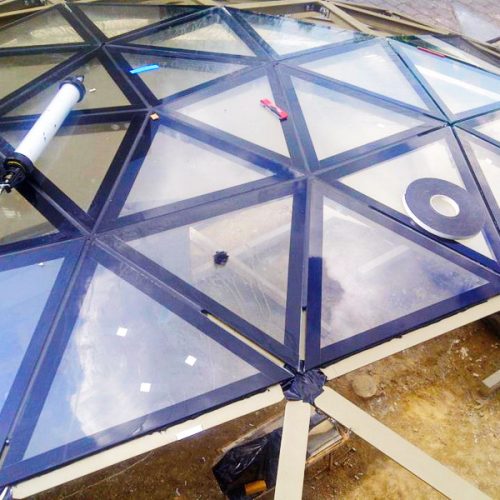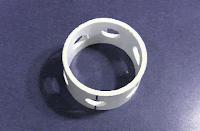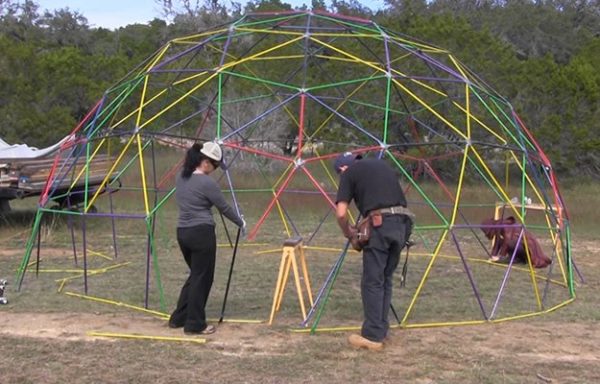The key materials chosen to create the main geodesic dome structure were timber cut at two sizes (730mm and 840mm), a large aluminium flat sheet and screws.
The timber was cut at longer and shorter lengths in order to create or triangular sections. We laid out the timber on the grass in order to plot out where the timber would connect and meet the other triangular sections to create the main structure.
We chose to use aluminium flat sheet to create our brackets as it was flexible and would suit the dome's natural bends once erected. We cut the aluminium flat sheet into strips based on the thickness of the timber. We then curved the strips into circles and marked out where the timber would intersect into the aluminium.
Following this, we fixed the timber to the circular strips using screws and then repeated the process on the remaining triangular sections.
Once the structure was connected together and laid flat on the ground, we erected it by lifting from the centre and then connected the base areas together using the longer pieces of timber and the aluminium strips.
Geodesic Dome
Sunday, April 29, 2018
Saturday, April 28, 2018
Thursday, April 26, 2018
Friday, April 20, 2018
Window Detail
Basic type for green houses
Window can be made from perspex and set on top of the dome frame. The image below portrays how the window was laid on top of one of the structural triangles.
In order to ensure the window frame maintains waterproof, silicon was used to line the edges of the frame. This prevents the water from getting inside and the water will then slide down to the bottom of the structure.
Thursday, April 19, 2018
Possible connection details
Bolts
Put the PVC hubs together by threading a 1/4" bolt through the holes, leaving long enough bolts to attach coveringHubs
Hubs connect all of the struts together to form the structure.
Gumdrops
Connected by gumdrops for small scale experiment
Welding
Connected in the center via welding
Overlapping pipes
Connected by steel pie with bolts, this is a quite good method to be considered.
Overlapping connection with each other. This way might not work due to the scale of the structure.
PVC Hub
Connected by cutting PVC hub as a connector and fixed with cable tiesBracket
Connected by bracket with bolts through timbers
References:
http://www.ziptiedomes.com.au/
https://makezine.com/2015/04/10/build-functional-geodesic-dome-pvc/
http://www.instructables.com/id/How-to-build-a-PVC-geodesic-dome/
Wednesday, April 18, 2018
Dome building methods - Beveled frame
The beveled
frame method is the most flexible and efficient dome building system. You start by putting bevel down one side of the timber.
Alternatively, use a thicker piece
of wood and cut down the center so you get two piece of timber and there will
be no waste.
The face of the timber frame is flush with the face of the
panel
Prepare 3 struts with beveled edges. You then screw the 3 struts together and trim off the ends flush.
This gives you a triangle frame with bevel on all the outside edge. When you join another one to it, it kicks up and form the curvature of the dome.
With this system there is no central hub. The glass would then sit on top of frame
using double sided glazing tape, silicon seal behind the glass and between the
glass.
- Simple build method that is tolerant of DIY fabrication
- Cheap to make because there are no hubs to buy
- Very flexible, can be covered in pretty much any material
- Can be used on all building types, maybe not for tents
Disadvantages:
Source: https://www.youtube.com/watch?v=JRbTyFK2m7s- Hard to cut the angles of the wood
http://geo-dome.co.uk/article.asp?uname=geo_polydome
Dome building methods - Tube and hub
Advantage:
- It can be disassembled easily because it is usually bolted.
Disadvantages:
- A lot of hubs needed for the construction and several different types are needed. The cost of adding hub is high, so it is a fairly expensive way to build.
- If the cover is a hard material, there will be a void above the strut and above the hub, which is not desirable
http://geo-dome.co.uk/article.asp?uname=tubehub
https://www.ziptiedomes.com/2vmanual.htm
Dome building methods – Arrowhead
This method does not use hub, just make angle at the end of
each strut and connect them together. Because it uses no hub, it is a cheaper
method to build a dome. However, there are a lot of issues with this method.
There are a lot of compound angle. The angle need to be cut
accurately. even just 1mm difference will add up to pushing frame apart and
form gap.
There are too much screws close together to hold the strut. Also
they are close to the end which is can break the strut.
Advantages:
- Cheaper way to build because it doesn’t use hub
Disadvantages:
- Very awkward to cover in any material except a fitted canvas
- Not structurally sound, screws can tear out
- Hard to disassemble, if you need to move it
Source:
https://www.youtube.com/watch?v=HBUVu9uXyPs
Dome building methods - flattened conduit
The flattened conduit is another method looked into for possible construction. This Process involves flattening the end of some metal tubing bend it slightly then drill a hole. Do this to both ends get yourself a bag of bolts and you can easily build a dome framework.
Advantages:
Advantages:
- Easy to assembled/disassembled, no special tools required, just make sure you don't split the tube when you flatten it and that you flatten enough so you can put the bend in without interfering with other struts.
- Quite crude. Also this type of dome framework is usually covered in canvas or similar material, which can be quite difficult to get tight and crease free over the structure. Also of the unevenness of the joints can make it difficult to cover cleanly.

Source: https://www.youtube.com/watch?v=RasWKQfpFzY
http://geo-dome.co.uk/article.asp?uname=flatcon
https://diyprojects.com/build-268-square-foot-geodesic-dome-for-300/
Sunday, April 15, 2018
The Strength Behind The Dome
As a structure the geodesic dome is strong and stable due to the frame being constructed through triangles.Triangles are the strongest structural shape as the have all fixed angles, and are very difficult to distort. This is achieved through the triangle's ability to spread loads. For example if a force is placed on one side of the triangle, its load will be spread and supported throughout the other two sides. In order to achieve this strength and a sturdy dome, the struts assembled in a triangle are called trusses which must be cut exactly to scale and the straight ends of these trusses must meet at a middle point called the node.
Benefits and Construction of the Geodesic Dome
The Geodesic dome's robust structure allows for any occupant
under the dome to be secure from any sort of external elements such as wind and
rain. The dome's unique structure allows for it to increase its strength as the
structure increases in size as its main strength is dependant on its structural
supports.
Geodesic domes allow for a relatively easy way to assemble which can be completed in a short amount of time. These domes being
connected as one structure can also be easily moved from site to site.
Geodesic domes can be assembled using predominantly recycled
materials such as timbers and steel, reducing the amount of negative
impacts on the environment. The domes when used as a form of housing can be
significantly energy efficient due to the insulating properties of its
components.
The most basic geodesic dome design consists of an icosahedron
with 20 faces that are equilateral triangles, the more triangles the larger the
dome, resulting in a stronger structure. The rods or struts that build up the
frame of the dome can be made with metals or timbers depending on the lengths.
Steel is commonly used in making the areas that connect to the struts/ rods.
Once the frame of the dome has been assembled, the
triangular spaces can be covered using materials such as timber, plastic,
concrete or plasters.
 |
| stevenbrace.co.uk |
What is Geodesic Dome Frequency?
Dome Frequency is denoted by the letter "v".
"2v" is short for "2 frequency". A
2v dome is a 2 frequency dome, and a 3v dome is a 3 frequency dome. 2 frequency has two different lengths and 3 frequency has three different lengths.
The short explanation for dome frequency is, the higher the
"v", or frequency, the more triangles there are in the geodesic
dome. A higher frequency dome with more triangles will be stronger and
more spherical than a lower frequency dome, and the higher frequency dome will be more complicated to
build, as it will have more struts.
Monday, April 9, 2018
What makes up the Dome
A geodesic Dome is an arrangement of triangles. They are efficient structures as the triangles are a very stable shape. This makes the geodesic dome buildings highly resistant to forces such as snow coverings, earthquakes, wind, and even tornadoes. The surface area of a geodesic dome is substantially less than the surface area of a box-shaped building enclosing the same floor space. There is less surface exposed to outdoor temperature fluctuations, making the building cheaper to heat and cool than a rectilinear structure.
An advantage of the geodesic dome is that it can be constructed quickly without heavy equipment using prefabricated components. The dome supports itself without needing internal columns or interior load-bearing walls. FIG. 1 shows how the triangles are placed.
Subscribe to:
Comments (Atom)




































